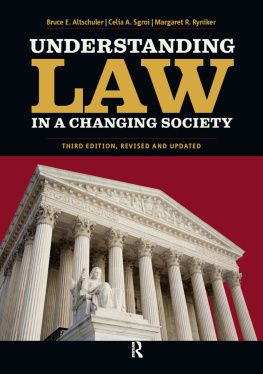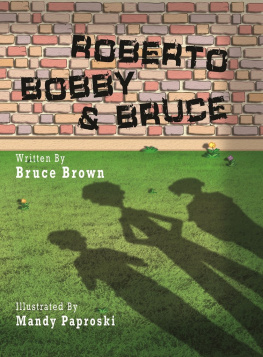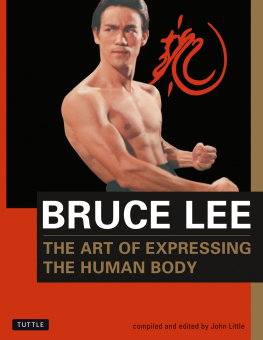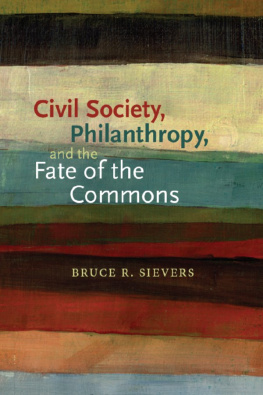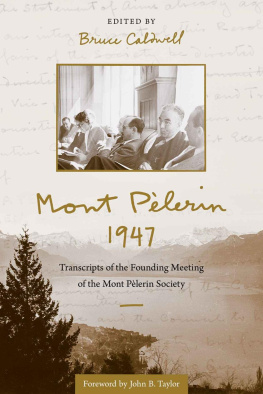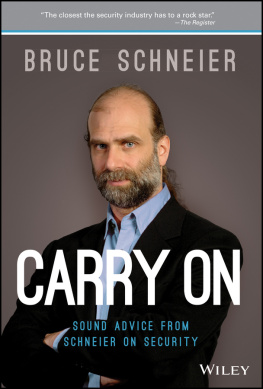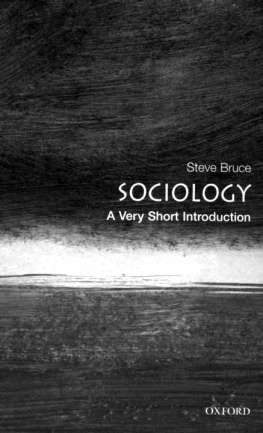First published 2010 by Paradigm
Publishers Published 2016 by Routledge
2 Park Square, Milton Park, Abingdon, Oxon OX14 4RN
711 Third Avenue, New York, NY 10017, USA
Routledge is an imprint of the Taylor & Francis Group, an informa business
Copyright 2010, Taylor & Francis.
All rights reserved. No part of this book may be reprinted or reproduced or utilised in any form or by any electronic, mechanical, or other means, now known or hereafter invented, including photocopying and recording, or in any information storage or retrieval system, without permission in writing from the publishers.
Notice:
Product or corporate names may be trademarks or registered trademarks, and are used only for identification and explanation without intent to infringe.
Library of Congress Cataloging-in-Publication Data
Altschuler, Bruce E.
Understanding law in a changing society / Bruce E. Altschuler, Celia A. Sgroi, and Margaret R. Ryniker. 3rd ed., rev. and updated.
p. cm.
Includes bibliographical references and index.
ISBN 978-1-59451-717-4 (pbk. : alk. paper)
1. LawUnited States. I. Sgroi, Celia A., 1949 II. Ryniker, Margaret R., 1950 III. Title.
KF385.A4A45 2009
349.73dc22
2009017109
Designed and Typeset by Straight Creek Bookmakers
ISBN 13 : 978-1-59451-717-4 (pbk)
Welcome to the revised and updated third edition of Understanding Law in a Changing Society. To most Americans, the law, especially noncriminal law, is a mystery that only someone with a law degree can solve. This text attempts to show that an undergraduate student with little or no previous knowledge of the law can understand the basic elements of the subject. This book will not make you a lawyer, but after reading it you will understand a great deal more about the substance and language of the law and how courts interpret them.
This text has three main purposes: (1) to introduce you to the basic concepts and processes of American civil (noncriminal) law; (2) to acquaint you with the analysis and interpretation of judicial opinions as a major source of American law; and (3) to provide some insight into the ways law and social change affect one another. The text is divided into two parts: the first deals with legal process, focusing on the institutions and rules by which cases are heard and decided, and the second deals with substantive law, emphasizing the concepts and rules that establish legal rights and obligations. Primary materialsjudicial opinions and readings from various legal commentatorsare included throughout the text to demonstrate how legal rules are made and applied.
As the book title indicates, one of our major concerns in this text is to acquaint you with law within its social context and, specifically, within a context of political and social change. In other words, in many instances we will be looking at law both in terms of how changes in society affect the law and how the law effects changes in society. For example, when the Court of Appeals, the highest court in New York State, ruled that two homosexuals living together in a rent-controlled apartment were a family for purposes of New York Citys rent control law, that change in the way the court interpreted the concept of family stemmed in large measure from changes in the way society views alternative sexual practices as well as changes in the traditional view of the family. Once such a precedent is established, it can pave the way for subsequent changes, so that other nontraditional groupings of unrelated individuals may in the future be regarded as a family for the same or other purposes. For example, New York City subsequently passed a law permitting cohabiting couples, whether heterosexual or homosexual, to qualify for certain benefits, such as bereavement leave; however, in 2004, the Massachusetts Supreme Court went far beyond these rulings to declare that gay couples have a constitutional right to marry, a notion that would have been unheard of in the past and is still extremely controversial.
People in society generally believe in progress; therefore, they expect to see changes occur. Moreover, most people believe in what is called an instrumental theory of law. That is, they see law as a means of doing things that need to be done. This view is an active one that leads to change. Additionally, people have come to expect the government, including the legal system, to be deeply involved in change, reform, and improvement of social and economic conditions. Generally, the effects of social forces on law and of law on society are best seen in the workings of the legislature, but courts are not immune from these forces. Courts do have significant limitations as instruments of social change, however. Civil litigation, for example, arises from demands of private individuals. These demands largely condition the workload of the courts and the law that will be made. If no one is disputing about trade secrets in a given year, that legal subject will not be addressed by the court. Because the court rules specifically on the issue(s) raised by the particular case before it, it cannot make law in a comprehensive fashion the way a legislature can.
Moreover, the operation of our courts is by nature conservative, because courts generally look to past precedents to decide the cases before them. This looking to the past in considering present and future problems is not exactly conducive to change. Courts have their own jurisdiction and rules of operation, which are distinct from those of the legislature, and they may not usurp legislative functions. But even though the court and its actors, the judges and lawyers, follow the internal rules and logic of the legal system, they do so in response to the demands of litigants from the outside world with their own interests and agendas.
The courts and their decisions cannot deviate too greatly from external social forces and demands without being looked on as wrong, outdated, or dysfunctional in some way. For individuals and groups who lack significant political power, civil litigationselective, conservative, slow, and uncertain as it often ismay be the only opportunity to effect social change. For example, from its inception the National Association for the Advancement of Colored People (NAACP) used the courts as a means to achieve equal rights for blacks. In the 1950s and 1960s, when filibusters in Congress blocked action on civil rights legislation, civil rights groups took to the courts to secure relief, such as in Brown v. Board of Education, the landmark school desegregation case. Another tactic frequently used by those lacking political power is to bring a so-called test casethat is, to support financially a litigant who brings a lawsuit challenging a particular law.
This is not to say that using civil litigation as a tool to effect change is easy or straightforward, no matter how necessary it may be for some people. As is the case with the legal system as a whole, the use of civil litigation is sometimes encouraged and often discouraged, and decisions about relative costs and benefits will certainly deter a great many marginal users of the system. The cost of litigation is high and the system is slow and cumbersome, posing serious barriers to its use. Nevertheless, in some situations a means of circumventing the barriers is created, such as the use of the contingent fee in tort cases, many of which could not be brought if attorneys fees had to be paid up front.


